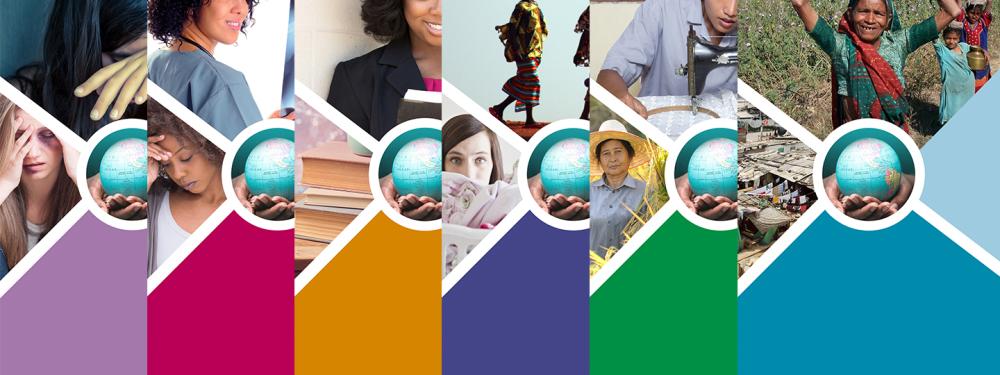Women's Ministries Six Challenge Issues
Women's Ministries Department identified critical issues that impact women worldwide which are the focus of their ministry. The six challenge issues are:
- Illiteracy
- Poverty
- Health Threats for Women
- Woman's Workload
- Abuse and domestic violence
- Lack of Training, Mentoring and Leadership Opportunities
As Christians, seeking to follow the example of Jesus, we believe that it is important to do what we can to meet the needs of all people, developing trust, and helping them to find the answers to their needs. For this reason, Women's Ministries has chosen to focus much of its attention to these challenges.
Before much can be done to address most of these needs, a person must be able to read. Almost one billion adults cannot read; about three-fourths of these are women. They cannot read the instructions on a medicine bottle, fill out an employment form, or read the directions for a household cleaner. Neither can they read a Sabbath School lesson to a child nor read the Bible. Like many in the Dark Ages, they must get their Gospel from someone else.
These are certainly challenges for everyone in the church. Women's Ministries invites all to join together to share the Good News of the Gospel.
ILLITERACY
(Education/Literacy Level)
![]() Education is accorded to the privileged. Globally, lack of education and illiteracy continues. Overall, even in affluent countries, girls receive less education and training than boys. In Sub-Sahara Africa and areas of South Asia as few as 5-8% of the women have basic reading skills. Yemen leads the world in female illiteracy 3% of the women able to read.
Education is accorded to the privileged. Globally, lack of education and illiteracy continues. Overall, even in affluent countries, girls receive less education and training than boys. In Sub-Sahara Africa and areas of South Asia as few as 5-8% of the women have basic reading skills. Yemen leads the world in female illiteracy 3% of the women able to read.
Illiteracy is powerfully linked to low social status, poverty, and poor health. Lack of literacy skills traps women into the cycle of poverty with limited options for economic improvement, sentencing their children to chronic poverty and limited education and training opportunities. Frequently the only "skill" a poor woman has to support her children is to sell herself. When sex becomes a bargaining chip for daily bread and ignorance blocks opportunity to escape from poverty, the soil is fertile for the pandemic of AIDS.
Lack of female literacy is also closely associated with increased infant and child mortality and illness. If the children are to live and to thrive, the mother must be given a lamp unto her feet — the skill of literacy. Further, illiterate women are blocked from reading the word of God. This barrier cripples them in their spiritual growth and in the spiritual training of their children.
Download PPT | Brochure PDF
POVERTY
![]() According to the 1993 State of the World, the richest 25% of the world's population absorbs 90% of the resources of the world. Among the poorest people in the world are women. Poverty is increasingly a feminine social disease. According to the International Labor Organization of the United Nations, women who globally represent 50% of the world's population, do two-thirds of the world's paid and unpaid work, earn 10% of the money in the world and own 1% of the world's property. Feminine poverty is related to four key factors:
According to the 1993 State of the World, the richest 25% of the world's population absorbs 90% of the resources of the world. Among the poorest people in the world are women. Poverty is increasingly a feminine social disease. According to the International Labor Organization of the United Nations, women who globally represent 50% of the world's population, do two-thirds of the world's paid and unpaid work, earn 10% of the money in the world and own 1% of the world's property. Feminine poverty is related to four key factors:
- global deterioration in the economy
- migration from rural to urban areas due to environmental degradation and declining soil fertility resulting in hunger
- global conflict resulting in refugee movements, most, of whom are women and children; and
- widespread female head of household status
It is estimated that one-third to one-half of all households worldwide are headed by women, a major risk factor for poverty as women overall simply do not make as much money as men. The poverty cycle tightens for poor women who have limited education, limited job opportunities and responsibility for growing children without sufficient resources.
Download PPT | Brochure PDF
THREATS TO HEALTH
(Poor Health Status)
![]()
Poor health undermines woman's ability to be a fully productive participant in God's work. Globally, the health of women is deteriorating. This process is closely aligned to environmental deterioration, declining agricultural productivity, and social demands on women, particularly in poor countries, for the production of large numbers of children. In many parts of the world, the devalued social status of being born female sentences the woman to less claim on food and health care.
Fifty percent of all poor women and two-thirds of pregnant poor women in less developed countries are anemic, robbing them of energy and physical resources to give their best to the new lives they nurture in their bodies. Maternal mortality remains the leading cause of death among women globally. One-half million women die each year from childbearing related complications. For every one that dies, twenty are physically damaged in the process of giving life. Maternal mortality has been called the "silent epidemic."
Download PPT | Brochure PDF
A WOMAN'S WORKLOAD
![]()
Women in poorer countries routinely work 18 hours per day. In some parts of the world, according to the Food and Agriculture Organization of the United Nations, women do 90% of all the agricultural work. Frequently expected to perform a full day's paid work for the financial viability of the family, a woman then faces additional hours of daily housework and child care, often with limited access to basic necessities of fuel and water. In many parts of the world, women have no voice in the distribution of family funds to which they have contributed. Some studies have shown that when women have some decision making voice in income allocations, the health, nutrition and education needs of the children are more likely to be given priority.
In the affluent world, the long working day also affects women with heavy expectations for job performance while maintaining family integrity. Balancing the societal expectations for maintaining an intact and healthy family while achieving in a highly competitive work environment results in long days and limited rest and recreation. Literature on women's health identifies chronic fatigue syndrome as a growing phenomena among women in both poor and affluent countries.
Download PPT | Brochure PDF
ABUSE
![]()
Girl children are often valued primarily for their contribution to the household work while their brothers are privileged to receive more education, food and health care. Incest, child pornography, the selling of the girl child into prostitution, and early arranged marriages are settings for abuse and torture. Bride burning, rape, female genital mutilation and emotional battering are further examples of common abuse experiences of women.
Physical abuse has been documented in one out of every six pregnancies in the United States except when the expectant mother is an adolescent, in which the abuse rate is one out of every three pregnancies. The abused victim learns to expect battering and to blame herself for its occurrence until it breaks her spirit. Violence against women is frequently a hidden sin but it is a direct violation of Christ-centered behavior. As such, tolerance of abuse within the church is a denial of Christ.
Download PPT | Brochure PDF
LACK OF TRAINING, MENTORING AND LEADERSHIP OPPORTUNITIES
![]()
Women's opportunities for leadership and advancement are limited in almost every country of the world.
Women have always worked, whether in the home, in support of their husbands, or for pay. They have always been involved in the church, although predominantly in supporting roles. Historically, women have held very few leadership positions in the Seventh-day Adventist Church. Currently, there is a growing need in the church for more women to be involved at the leadership level. This underscores the need to equip and prepare women for this role. Unfortunately, most women have not had the advantage of leadership training and experience.
In Women's Ministries, we seek to value each woman and recognize her individual needs and gifts. To be on the cutting edge, a leader must also be involved in continuing education and training. She must keep up-to-date on new leadership trends and look for new ways to minister to others. The Department of Women's Ministries has developed materials to train women in leadership. The Leadership Certification training program has four levels and includes 63 seminars with PowerPoint presentations, overheads, and handouts. It is important that women, especially leaders, be involved in mentoring, serving not only as mentors but also as mentees. This ensures that each individual is not only receiving but also giving.
Download PPT | Brochure PDF




